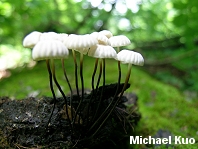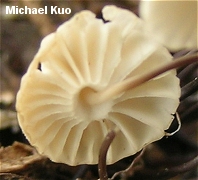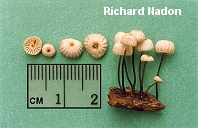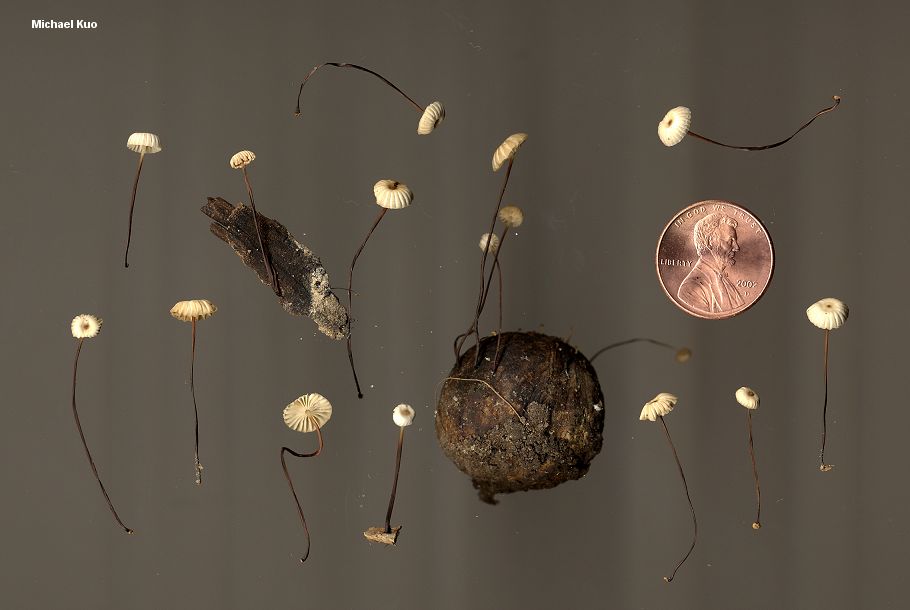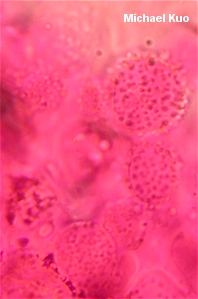| Major Groups > Gilled Mushrooms > Pale-Spored > Marasmioid > Marasmius rotula |

|
Marasmius rotula [ Basidiomycetes > Agaricales > Marasmiaceae > Marasmius . . . ] by Michael Kuo This eastern species, sometimes called the "pinwheel mushroom," is often overlooked because it is so tiny; the caps max out at two centimeters in diameter, and are usually half that size or smaller. It is found in hardwood forests from spring to fall, growing from sticks and other woody debris. That last detail is very important because Marasmius capillaris, which looks nearly identical, grows from leaf litter rather than wood. The attachment of the gills is by means of a tiny "collar" that circles the stem. Additional distinctive features include the dark, wiry stem; the pleated white cap that looks squarish when viewed from the side (the cap of Marasmius capillaris, in contrast, is usually more rounded); and the absence of a distinctive odor or taste. Other "pinwheel" species include the orange Marasmius siccus, the pink Marasmius pulcherripes, and the rusty-capped Marasmius fulvoferrugineus. Description: Ecology: Saprobic on sticks and woody debris in hardwood forests; growing alone or gregariously (or in clusters); spring through fall; widely distributed east of the Rocky Mountains. Cap: 5-20 mm; broadly convex; soon developing a navel-like central depression; pleated; usually appearing to have a flat top and squarish sides when viewed from the side; bald; dry; brownish in the depression, white elsewhere. Gills: Attached to a tiny "collar" that encircles the stem; white to yellowish white; distant. Stem: 1.5-8 cm long; 1-2 mm thick; equal; dry; shiny; wiry; pale at first but soon dark brown to black except at the apex; base sometimes with stiff hairs. Flesh: Thin. Odor and Taste: Not distinctive. Chemical Reactions: KOH on cap surface negative. Spore Print: White or whitish. Microscopic Features: Spores 6.5-10 x 3-5 µ; smooth; more or less elliptical, or subfusiform; inamyloid. Pleurocystidia absent. Cheilocystidia clavate to subglobose; inamyloid; with short warts and projections. Pileipellis hymeniform, with broom cells that feature short projections. REFERENCES: (Scopoli, 1772) Fries, 1838. (Fries, 1821; Saccardo, 1887; Kauffman, 1918; Gilliam, 1976; Smith, Smith & Weber, 1979; Arora, 1986; Breitenbach & Kränzlin, 1991; Phillips, 1991/2005; Lincoff, 1992; Horn, Kay & Abel, 1993; Barron, 1999; Roody, 2003; McNeil, 2006; Miller & Miller, 2006.) Herb. Kuo 06019513, 05260305, 06070302, 06100802, 05061202. This site contains no information about the edibility or toxicity of mushrooms. |
© MushroomExpert.Com |
|
Cite this page as: Kuo, M. (2012, December). Marasmius rotula. Retrieved from the MushroomExpert.Com Web site: http://www.mushroomexpert.com/marasmius_rotula.html |
